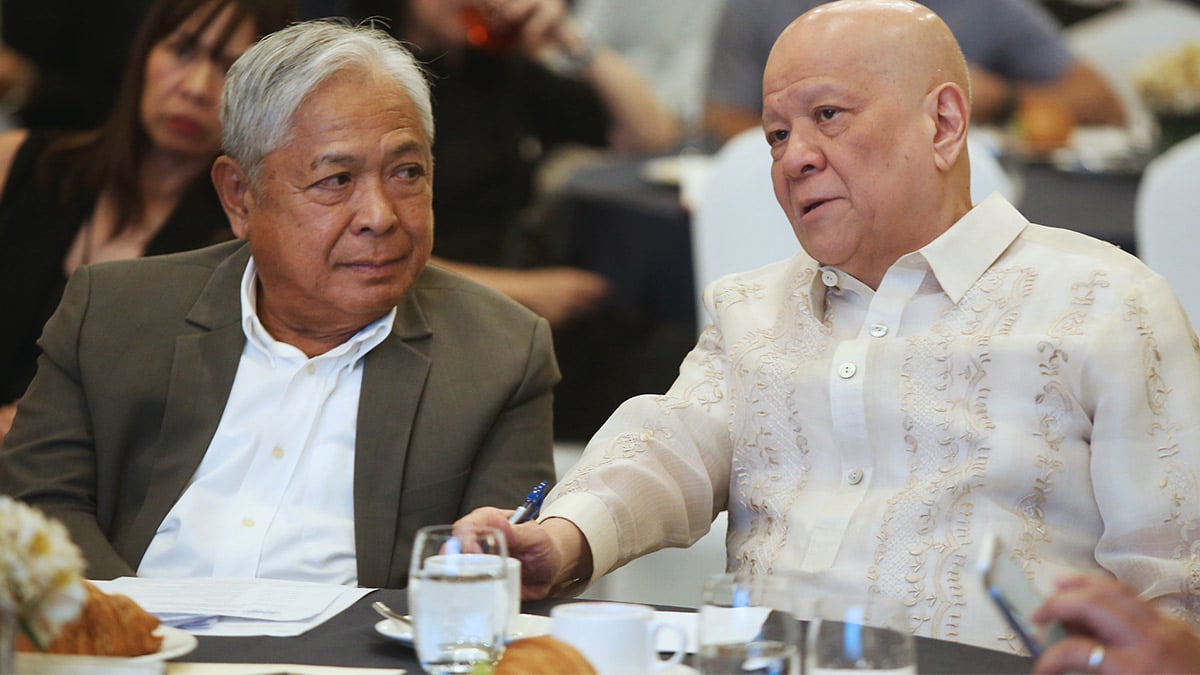Naia changes coming; Sept. 14 takeover set

MEETING OF THE MINDS Transportation Secretary Jaime Bautista (left) discusses with San Miguel Corp. chair Ramon Ang forthcoming improvements at Ninoy Aquino International Airport during the forum hosted by the Economic Journalists Association of the Philippines. —EUGENE ARANETA
The consortium led by conglomerate San Miguel Corp. is all set to take over Ninoy Aquino International Airport (Naia) on Sept. 14 and has laid out plans to reassign the airport terminals.
According to the proposal of New Naia Infrastructure Corp. (NNIC), terminal 2 will only service domestic flights.
READ: SMC group all set to take over Naia on Sept 14
Terminal 1, on the other hand, will be used exclusively by flag carrier Philippine Airlines (PAL) for its international flights. All the foreign airlines, meanwhile, will operate at terminal 3, which will also host the international flights of Cebu Pacific and AirAsia Philippines.
Domestic flights of Cebu Pacific will be moved to terminal 2 to join PAL’s, while AirAsia domestic flights will be moved to terminal 4.
Article continues after this advertisementImproved efficiency
At present, Naia terminal 1 is exclusive for international flights while terminals 2 and 4 are for domestic operations. Terminal 3 accommodates both local and international flights.
Article continues after this advertisementTerminal reassignment is seen to improve the efficiency of runway use, allowing the airport to accommodate more flights.
Under the concession agreement with the government, the consortium is tasked with increasing the aircraft movements per hour from 41 flights to 48 flights.
NNIC general manager Angelito Alvarez emphasized, however, that the terminal reassignments will be implemented gradually to avoid massive disruptions in airline operations.
READ: DOTR: No stopping hikes in Naia fees, charges
In an event hosted by the Economic Journalists Association of the Philippines in Makati on Monday, Alvarez said the relocation of terminal operations would be implemented over three years as the group expands passenger capacity.
“It will be a gradual process. That’s the best that we can do at this point in time,” he said, “NNIC will not disrupt current operations and will be business as usual.”
Airlines are open to the terminal reassignments and are looking forward to further consultations.
Cebu Pacific president and chief commercial officer Xander Lao said that ideally, no terminal reassignments should be implemented for now to avoid disruptions before Christmas when passenger volume usually picks up.
“As long as there’s a lot of consultation, there’s enough room and time for the airlines to plan, it’s not necessarily a controversial topic in terms of moving terminals,” he said.
Plans for Naia
Ricky Isla, AirAsia Philippines CEO, said they would want to discuss with the NNIC what improvements are expected with the move to terminal 4, raising possible concerns with the lack of passenger capacity.
“So in short, it needs some further discussion for the domestic Terminal 4,” he said.
For PAL, president Stanley Ng said they were “willing to work with the NNIC and also the DOTr (Department of Transportation) whichever will be the most efficient way for all the passengers.”
The DOTr earlier backed the NNIC’s plan to implement a terminal reassignment in a bid to make airport operations smoother.
The initial initiatives set by NNIC will focus on the comfort of the passengers when they are awaiting for their flights.
Within the first three to 12 months of the San Miguel group’s takeover, it will install new toilets and refurbish existing comfort rooms; place additional seating capacity; install more air conditioning units; and enable reliable high-speed internet.
Other plans in the short term include improved retail and food and beverage experience; power redundancy; repair of existing walkalators, escalators and elevators; upgrading of x-ray machines; and road expansion to terminal.
Recently, SMC chair and CEO Ramon Ang also said they were building an off-ramp connecting Naia Expressway to Naia terminal 3, which is eyed to be completed next year.
Within four to five years, Alvarez said they were set to fulfill their goal of increasing annual terminal capacity from 35 million passengers to 62 million.
Expansion
The San Miguel group, in the same time frame, also intends to link terminal 3 to the Metro Manila Subway, upgrade baggage handling system, use updated self check-in and self bag-drop counters and double the capacity of car parking.
“The focus on airport expansion and upgrading primarily hinges on a continued rise in passenger traffic as well as those that exhibit growth potential measured by increased tourism and economic activities,” DOTr Secretary Jaime Bautista said.
The Air Carriers Association of the Philippines and Board of Airline Representatives, in a statement on Monday, threw their support behind the upcoming Naia operator.
“We are eager to engage with NNIC and the government to address the potential adverse effects on travel demand and to ensure that the interests of both airlines and passengers are represented,” the groups said.
“We look forward to positive outcomes for all stakeholders in the course of the transition to privatized airport management and we earnestly await the holding of consultation meetings by NNIC that will clearly outline the steps to be taken for the upcoming transition on Sep. 14,” they added.
The Air Carriers Association of the Philippines and Board of Airline Representatives, in a statement on Monday, threw their support behind the upcoming Naia operator.
“We are eager to engage with NNIC and the government to address the potential adverse effects on travel demand and to ensure that the interests of both airlines and passengers are represented,” the groups said.
“We look forward to positive outcomes for all stakeholders in the course of the transition to privatized airport management and we earnestly await the holding of consultation meetings by NNIC that will clearly outline the steps to be taken for the upcoming transition on Sep. 14,” they added.